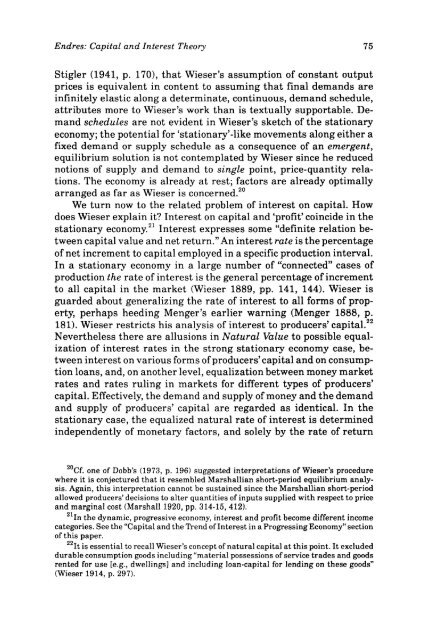Review of Austrian Economics - The Ludwig von Mises Institute
Review of Austrian Economics - The Ludwig von Mises Institute
Review of Austrian Economics - The Ludwig von Mises Institute
Create successful ePaper yourself
Turn your PDF publications into a flip-book with our unique Google optimized e-Paper software.
Endres: Capital and Interest <strong>The</strong>ory 75<br />
Stigler (1941, p. 170), that Wieser's assumption <strong>of</strong> constant output<br />
prices is equivalent in content to assuming that final demands are<br />
infinitely elastic along a determinate, continuous, demand schedule,<br />
attributes more to Wieser's work than is textually supportable. Demand<br />
schedules are not evident in Wieser's sketch <strong>of</strong> the stationary<br />
economy; the potential for 'stationary'-like movements along either a<br />
fixed demand or supply schedule as a consequence <strong>of</strong> an emergent,<br />
equilibrium solution is not contemplated by Wieser since he reduced<br />
notions <strong>of</strong> supply and demand to single point, price-quantity relations.<br />
<strong>The</strong> economy is already at rest; factors are already optimally<br />
arranged as far as Wieser is concerned. 20<br />
We turn now to the related problem <strong>of</strong> interest on capital. How<br />
does Wieser explain it? Interest on capital and 'pr<strong>of</strong>it' coincide in the<br />
stationary economy. 21 Interest expresses some "definite relation between<br />
capital value and net return." An interest rate is the percentage<br />
<strong>of</strong> net increment to capital employed in a specific production interval.<br />
In a stationary economy in a large number <strong>of</strong> "connected" cases <strong>of</strong><br />
production the rate <strong>of</strong> interest is the general percentage <strong>of</strong> increment<br />
to all capital in the market (Wieser 1889, pp. 141, 144). Wieser is<br />
guarded about generalizing the rate <strong>of</strong> interest to all forms <strong>of</strong> property,<br />
perhaps heeding Menger's earlier warning (Menger 1888, p.<br />
181). Wieser restricts his analysis <strong>of</strong> interest to producers' capital. 22<br />
Nevertheless there are allusions in Natural Value to possible equalization<br />
<strong>of</strong> interest rates in the strong stationary economy case, between<br />
interest on various forms <strong>of</strong> producers'capital and on consumption<br />
loans, and, on another level, equalization between money market<br />
rates and rates ruling in markets for different types <strong>of</strong> producers'<br />
capital. Effectively, the demand and supply <strong>of</strong> money and the demand<br />
and supply <strong>of</strong> producers' capital are regarded as identical. In the<br />
stationary case, the equalized natural rate <strong>of</strong> interest is determined<br />
independently <strong>of</strong> monetary factors, and solely by the rate <strong>of</strong> return<br />
20 Cf. one <strong>of</strong> Dobb's (1973, p. 196) suggested interpretations <strong>of</strong> Wieser's procedure<br />
where it is conjectured that it resembled Marshallian short-period equilibrium analysis.<br />
Again, this interpretation cannot be sustained since the Marshallian short-period<br />
allowed producers' decisions to alter quantities <strong>of</strong> inputs supplied with respect to price<br />
and marginal cost (Marshall 1920, pp. 314-15, 412).<br />
21 In the dynamic, progressive economy, interest and pr<strong>of</strong>it become different income<br />
categories. See the "Capital and the Trend <strong>of</strong> Interest in a Progressing Economy" section<br />
<strong>of</strong> this paper.<br />
It is essential to recall Wieser's concept <strong>of</strong> natural capital at this point. It excluded<br />
durable consumption goods including "material possessions <strong>of</strong> service trades and goods<br />
rented for use [e.g., dwellings] and including loan-capital for lending on these goods"<br />
(Wieser 1914, p. 297).

















